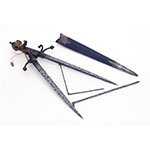Dagger-shaped compass for geometrical, surveying, and military applications. The functions of the instrument are described in a manuscript in the possession of Bartolomeo Ammannati and, later, Vincenzo Viviani. The dagger blade comprises parts that open like compass legs. The handle knob contained a magnetic compass with a dial, now missing. Inside the blades were two small graduated rods, one of them folding. They served to take measurements in palms and Florentine braccia, and to use the compasses as a plumb level. The sheath also contained a square enabling the instrument to be used for measuring verticals, slopes, distances, heights, and depths. In artillery, the dagger served to set guns to the horizontal and to measure the caliber and weight of shot. Another device for military use was the goniometric circle divided into eight 45° sectors. When attached to the handle, the circle enabled the user to measure the dimensions of fortresses and draw their plans. Provenance: Vincenzo Viviani bequest.










